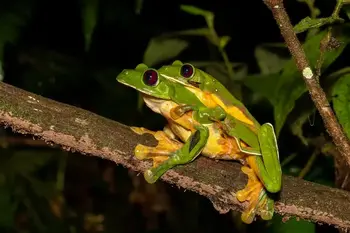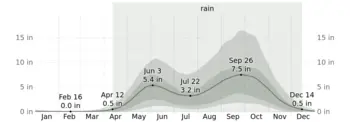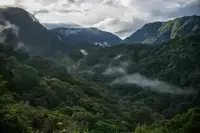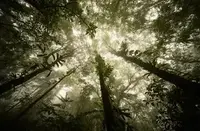Best Times to See Reptiles and Amphibians in Costa Rica
Discover Why the Wet Season Offers Prime Herping Opportunities

Herping in Costa Rica: Wet Season Benefits and Timing | January 25, 2025
Last updated: October 23, 2025
This article is entirely independent and contains no sponsored content or affiliate links — it’s written to provide unbiased information for travelers. Title photo by Etienne Delorieux.
The Wet Season: A Haven for Amphibians and Reptiles
In general, the wet season, which runs from late May through November, is the prime time to see reptiles and amphibians in Costa Rica. This period transforms the landscape, bringing an abundance of temporary ponds and standing water that serve as breeding grounds for frogs, toads, and other amphibians. The absence of predatory fish in these temporary water sources creates safer conditions for amphibian eggs and tadpoles, resulting in increased activity.
Why Amphibians Thrive in the Wet Season

- Humidity and Moisture: The wet season provides the necessary humidity for amphibians to remain active and explore broader territories.
- Breeding Opportunities: Amphibians depend on water to breed, and the wet season’s consistent rains provide ideal conditions.
- Abundant Food Supply: Damp environments allow insects to flourish, providing ample food for amphibians.
Why Snakes Follow the Frogs
Although reptiles like snakes don’t rely on water for activity or reproduction, the wet season draws them out to hunt the frogs and toads that become more active. This predator-prey dynamic makes the wet season an excellent time to observe snakes in action.
Regional Variations in Costa Rica
Pacific Coast
- Seasonality: The Pacific side has a pronounced wet and dry season, with heavy rains from late May to November.
- Considerations: The Nicoya peninsula and Guanacaste region of the Pacific Northwest of Costa Rica is by far the driest region in Costa Rica, and has an especially dry dry season. While the rainy season here, extends from May through November, September and October are exceptionally rainy. So much so that road closures can hinder travel. However, these months are ideal for spotting herps due to the surge in activity from amphibians and their predators.
Caribbean Side (Mid-Elevation Mountains)
- Rain Patterns: The Caribbean side experiences rain throughout the year, even during the dry season. While reptiles and amphibians are active year-round, the wet season remains the best time for herping.
- Advantages: Consistent humidity and lush conditions make this region less affected by seasonal extremes compared to the Pacific coast.
Key Differences: The Pacific coast’s herping opportunities may be more limited during the dry season, while the Caribbean side offers year-round potential with wet season peaks. For drier regions like Guanacaste, the rainy season is crucial for observing reptiles and amphibians due to the scarcity of water during the dry months.
Herping in the Rainy Season: What to Expect
For wildlife photographers and herping enthusiasts, the thought of constant rain might seem daunting. However, the rainy season in Costa Rica rarely involves non-stop downpours. Instead, rain typically falls for a few minutes to a few hours each day, often in the afternoon or evening. Mornings can be bright and sunny, providing excellent opportunities for exploration and photography. With proper preparation, the wet season becomes a manageable and highly rewarding time to visit.
Best Months for Herping
- Late May through August: Early wet season months offer increasing activity as amphibians and reptiles respond to the first rains.
- September and October in Guanacaste: These months bring peak rainfall, which can lead to incredible activity but may also pose travel challenges.
- November: The transition to the dry season can still provide excellent herping opportunities, with activity tapering off gradually.
Rainfall by Month
To show variation within the months and not just the monthly totals, we show the rainfall accumulated over a sliding 31-day period centered around each day of the year. The average rainfall (solid line) accumulated over the course of a sliding 31-day period centered on the day in question, with 25th to 75th and 10th to 90th percentile bands. These graphs were provided by WeatherSpark.com



Final Thoughts
The wet season is undoubtedly the best time to visit Costa Rica for reptiles and amphibians, offering unparalleled opportunities to observe and photograph these fascinating creatures. While the rains may seem intimidating, they are usually brief and add to the lush, vibrant environment that makes Costa Rica such a special destination for herping. Whether you’re exploring the Pacific coast or the humid forests of the Caribbean side, timing your trip with the wet season will maximize your chances of encountering the incredible biodiversity Costa Rica has to offer.





